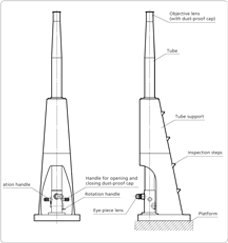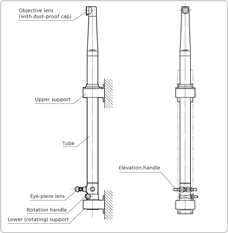
Shinkansen periscope used for inspecting cars
Japan boasts a world-class high-speed railway system—in the shape of the shinkansen. On October 1, 1964, Japanese National Railways (JNR) commenced operation of the Tokaido Shinkansen line between Tokyo and Shin Osaka stations. At the time, the shinkansen, which represented the epitome of Japanese railway technology, had a top speed of 210 km/h and was known as the "Dream Super Express." On April 1, 1987, Japanese National Railways was broken up and privatized. Today, the Tokaido Shinkansen is operated by Central Japan Railway Company.
The shinkansen is internationally renowned for its reliability and safety, as well as its high speed. What is not widely known is that Nikon (which bore the name Nippon Kogaku K.K. at the time) manufactured the periscopes that were used in the rail yard to inspect shinkansen cars.
The structure of the periscope
For most people, the word "periscope" probably conjures up images of a submarine. A submarine periscope is a tubular optical device that is raised above the surface of the sea from the submarine and used to observe the surrounding area. In other words, a periscope is a device that allows high locations to be viewed from a low position.
As for the optical path of the periscope, the light from the objective lens is directed 90° downwards by means of a prism. A relay lens inside the tube relays the image. A prism in the eye-piece then redirects the path of the light back into the horizontal plane and into the eyes of the observer.
Nikon has manufactured numerous periscopes for industrial use and for application in specialist fields. The shinkansen periscope is one such example.
Checking whether the pantograph is raised or lowered

PS200 pantograph on a 0 Series shinkansen car
(Photo by Seiya Nakai)
The first shinkansen periscope was built in 1966 at what was then the Tokaido Shinkansen Tokyo Operations Depot. This depot was near Shinagawa Station. The shinkansen periscope was used to check whether the pantograph, which is installed on the roof of a shinkansen car, was raised or lowered. At the time, cars of the 0 Series shinkansen were approximately 4 meters tall. The vantage point for inspection of the pantographs needed to be set higher than this.
As the pantograph is raised and lowered, current flows in the overhead power lines at a voltage of 25,000 volts. Using a periscope allowed the observer to avoid the risk of electrocution that the proximity of the overhead lines might otherwise entail.
The periscope and the distributed traction system

Stand-alone periscope fitted at the Tokaido Shinkansen Tokyo Operations Depot. A car from a 0 Series "Dr. Yellow" shinkansen test train can be seen in the background.
The use of periscopes on the shinkansen was certainly necessitated by the height of the cars and the danger from the high-voltage overhead lines. However, there was also an additional reason why periscopes were needed, a result of the distributed traction system that is a distinctive feature of the shinkansen. The shinkansen was comprised entirely of cars that were motive power units. This system—which was unique to the shinkansen—was the method chosen to make high-speed rail travel a reality in Japan, a country whose railways feature many curves and gradients.
Incidentally, coupling a motive power unit to the foremost or rearmost car in a train is known as a concentrated traction system. This system is standard on high speed railways in the West, where railway lines are usually straight and the stations far apart.
In the longest 0 Series shinkansen formation, which consisted of 16 cars, eight pantographs were required to supply power to each two-car unit.
A single shinkansen car is approximately 25 meters in length. To put it another way, to visually inspect all the pantographs on the longest (16-car) formation would require the observer to walk approximately 400 meters. The shinkansen periscope enabled rapid inspection and allowed reliable visual checking of the rearmost pantograph from the foremost car.
The shinkansen periscope—its specifications and operation
The eye-piece of the shinkansen periscope was 1.5 meters above ground level, and the objective lens was 3 meters above the eye-piece. In other words, the vantage point was situated 4.5 meters above ground level. The eye-piece was monocular and one of the eye-piece lenses was a dummy. However, to allow more stable observation, the eye-piece was binocular in form. The eye-piece could also be switched between right and left to suit the observer's dominant eye.
In terms of optical performance, the periscope had a magnification of 6x, a field of view of 8 degrees, and a 5-mm pupil diameter. This is similar to the performance of a set of low-magnification binoculars. It had a sealed structure to enable its use in dusty environments and was estimated to weigh approximately 250 kilograms.
The cylindrical handle on the right of the eye-piece is used to open and close the dust-proof cap, which is located in front of the objective lens. The cylindrical handle on the left is an elevation handle for moving the upper prism, which can be tilted upwards or downwards by 10°. The rear right rotation handle is used to rotate the tube. The tube can be rotated up to 90°.
The periscope is focused by rotating the eye-piece lens. The periscope's observational range of 25 m-400 m is perfectly suited to the length of the longest shinkansen formation.

Eye-piece

Objective lens (with dust-proof cap open)
Types of shinkansen periscope
The first installations of shinkansen periscopes were carried out at the Tokaido Shinkansen Tokyo Operations Depot in Shinagawa. Subsequently, installation work was also performed at the Mishima Rail Yard in Shizuoka Prefecture and the Torikai Rail Yard in Osaka. Although the basic structure of the periscope was not altered, several variations existed.
A section with yellow and black warning stripes supported the tube of the stand alone periscope. The designers, who were then responsible for the periscope, related that they had received strict instructions from JNR at the time regarding the color tones and width to be used for these warning stripes. This was probably due to safety considerations. The wall-mounted periscope was attached to the wall and secured with two supports.
In addition, the periscopes, which were fitted at the Torikai rail yard, were installed higher off the floor and were specified to be roughly 2 meters in length from the eye piece to the objective lens.
The shinkansen periscope went by a variety of names in—house—the "rail car periscope," the "shinkansen periscope," or the "pantograph elevation verification device" (as on the blueprints submitted to JNR).
The end of the line for the shinkansen periscope
Due to its distributed traction system, the shinkansen once required multiple pantographs. However, subsequent technological advances have reduced the number of motive power units and improved pantograph reliability, resulting in a modern-day shinkansen that is capable of running on as few as two pantographs. The way in which pantographs are inspected has also changed, with today's methods involving observation using TV cameras and the installation of aerial walk-ways. For these reasons, the shinkansen periscope became obsolete, and by 1998 all shinkansen periscopes had been removed.
For over 30 years, however, the shinkansen periscope performed a vital service by enabling the inspection of shinkansen cars, and thus deserves to be more widely remembered for the contribution it made to the safety and reliability of the shinkansen.
Compiled with the cooperation of Central Japan Railway Company, the Railway Museum and the Nikon Former Employees Association.



